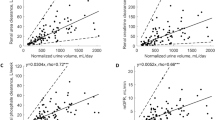Abstract
The recovery of renal function following release of urinary tract obstruction with advanced azotemia determines both the need for emergency dialysis in the early post-obstructive period and the long-term planning for chronic kidney disease management. A man with prostatic cancer who presented with 16 days of anuria and a serum creatinine (Scr) of 42.7 mg/dl but had evidence suggesting residual renal function was managed conservatively and reached a steady-state Scr of 1.6 mg/dl within 84 h of urinary bladder catheterization. Modeling of the decrease in Scr taking into account the decline in the body creatinine pool that existed prior to the release of the obstruction and the accumulation in body fluids of creatinine produced after the release of the obstruction suggested that recovery of the value of glomerular filtration rate corresponding to the steady-state Scr occurred at the release of the urinary obstruction. The case illustrates both the clinical factors that may lead to the decision to postpone dialysis in a patient presenting with extreme obstructive azotemia and a novel method of modeling the recovery of renal function after release of the obstruction.
Similar content being viewed by others
References
Zawada ET Jr (2001) Initiation of dialysis. In: Daugirdas JT, Blake PG, Ing TS (eds) Handbook of dialysis, 3rd ed. Lippincott Williams & Wilkins, Philadelphia, pp 3–11
Koda-Kimble MA, Young LY, Michael E (1994) Winter’s basic clinical pharmacology, 2nd ed. Applied Therapeutics Inc., Vancouver
Tzamaloukas AH (1995) Can excess of estimated over predicted creatinine generation be a discriminating test for non-compliance in continuous ambulatory peritoneal dialysis? J Am Soc Nephrol 6:1519–1520
Tzamaloukas AH (1996) Pharmacokinetic analysis of creatinine generation discrepancy as an index of noncompliance in CAPD. Adv Perit Dial 12:61–65
Bishop MC (1985) Diuresis and renal functional recovery in chronic retention. Br J Urol 57:1–5
Zeidel ML, Pirtskhalaishvili G (2004) Urinary tract obstruction. In: Brenner BM (ed) Brenner and Rector’s the kidney, 7th ed. Saunders, Philadelphia, pp 1867–1893
Baker LRI, Whitfield HN (1998) The patient with urinary tract obstruction. In: Davison AM, Cameron JS, Grunfeld J-P, Kerr DNS, Ritz E, Winearls CG (eds) Oxford textbook of clinical nephrology, 2nd ed. Oxford University Press, Oxford, pp 2523–2542
Gulmi FA, Felsen D, Vaughan ED Jr (2002) Pathophysiology of urinary tract obstruction. In: Walsh PC, Retik AB, Vaughan ED Jr, Wein AJ (eds) Campbell’s urology, 8th ed. Saunders, Philadelphia, pp 411–462
Bricker NS, Shwayri EI, Readan JB et al (1957) An abnormality in renal function resulting from urinary tract obstruction. Am J Med 23:554–564
Olbrich O, Woodford-Williams E, Irvine RE et al (1957) Renal function in prostatism. Lancet 1:1322–1324
Nadig PW, Valk WL (1962) Recovery from obstructive disease. J Urol 88:470–472
Roberts SB, Lattimer JK (1965) Reversibility of renal functional impairment after prostatic obstruction. J␣Urol 93:545–547
Peterson LJ, Yarger WE, Schocken DD et al (1975) Post-obstructive diuresis: a varied syndrome. J Urol 113:190–194
Ghose RR (1990) Prolonged recovery of renal function after prostatectomy for prostatic outflow obstruction. Br Med J 300:1376–1377
Massry SG, Schainuck LI, Goldsmith C et al (1967) Studies on the mechanism of diuresis after relief of urinary-tract obstruction. Ann Intern Med 66:149–158
Sarmina J, Resnick MI (1989) Obstructive uropathy in patients with benign prostatic hyperplasia. J Urol 141:866–869
Jones DA, George NJ, O’Reilly PH et al (1988) The biphasic nature of renal functional recovery following relief of chronic obstructive uropathy. Br J Urol 61:192–197
Cockroft DW, Gault MH (1976) Prediction of creatinine clearance from serum creatinine. Nephron 16:31–41
Levey AS, Bosch JP, Lewis JB et al (1999) A more accurate method to estimate glomerular filtration rate from serum creatinine: a new prediction equation. Modification of Diet in Renal Disease Study Group. Ann Intern Med 130:461–470
Watson PE, Watson ID, Butt PD (1980) Total body water volumes for adult males and females estimated from simple anthropometric measurements. Am J Clin Nutr 33:27–39
Mitch WE, Walser M (1978) A proposed mechanism for reduced creatinine excretion in severe renal failure. Nephron 21:248–254
Keen M, Lipps B, Gotch F (1993) The measured creatinine generation in CAPD suggests only 78% of the prescribed dialysis is delivered. Adv Perit Dial 9:93–95
Acknowledgement
This work was supported by the New Mexico VA Health Care System.
Author information
Authors and Affiliations
Corresponding author
Rights and permissions
About this article
Cite this article
Wang, R., Tzamaloukas, A.H., Agaba, E.I. et al. Management of extreme azotemia from urinary tract obstruction without dialysis. Clinical correlates and kinetic modeling of the recovery of renal function. Int Urol Nephrol 39, 587–593 (2007). https://doi.org/10.1007/s11255-006-9035-3
Received:
Accepted:
Published:
Issue Date:
DOI: https://doi.org/10.1007/s11255-006-9035-3




